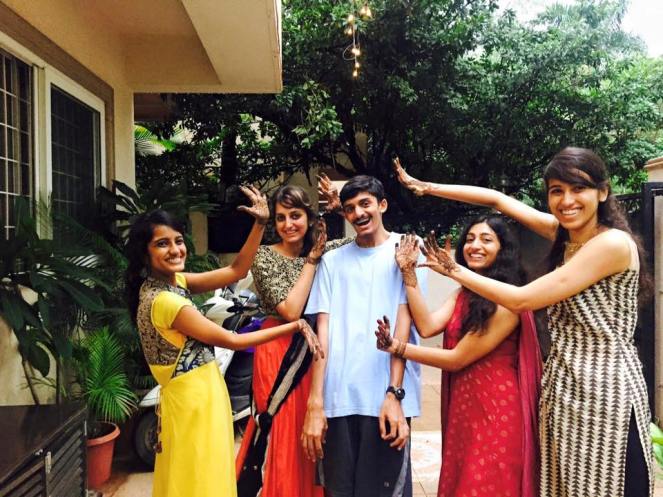Across Worlds and Identities: The Spaces in Between
 A reflection by Women’s Center staff member Prachi Kochar on identity and “fitting in”. How do we navigate identities that can fit into multiple categories of nationality, ability, race, etc. at once? Or identities that do not perfectly fit into these categories, spilling out and crashing into each other?
A reflection by Women’s Center staff member Prachi Kochar on identity and “fitting in”. How do we navigate identities that can fit into multiple categories of nationality, ability, race, etc. at once? Or identities that do not perfectly fit into these categories, spilling out and crashing into each other?
This summer, I went to India for my cousin’s wedding, and it was a long trip both physically (twenty-four hours of traveling, with a layover!) and mentally. Even though it has technically been over for months, it continues to affect the way that I think and view the world. It has deepened my understanding of how I navigate the world, both in terms of my physical location and in terms of social situations and relationships.
Before this trip, I had assumed that India was nothing more or less than a second home to my parents, that it was their equivalent of me coming home from school for winter or summer vacation. However, after an interaction with some distant relatives, my mother turned to me and shook her head, saying “They act like we’re not even Indian!” Her comment surprised me because my parents always had been the epitome of Indian to me. In their spare use of Gujarati and Marathi words, I had heard the voice of India, my motherland. Through their cooking, through the bhinda, rotis, and dal, I had tasted my heritage. And in their stories about their childhoods, about school, about their friends, everything, I had experienced life in India.
 Mehndi ceremonies with family in India
Mehndi ceremonies with family in India
Even though I had known they had lived in the United States for the majority of their lives, eventually becoming US citizens, I was still amazed. My mother explained to me, “We’re too American for the Indians, but then we go home and we’re too Indian for Americans.” At this point, it was difficult for me to not laugh and/or cry out loud, because I had said that same sentence nearly word-for-word in multiple contexts. Later, once we had gotten a break from the wedding chaos, I asked my parents about the exchange again. They both expressed similar feelings, even though they’d had very different experiences of growing up in India and even though my mother is technically South African. Not American enough, but also not Indian enough, they echoed. In the end, I was left with one question playing through my head over and over. What does “enough” mean?
For me, that question makes up the chorus of the soundtrack of my life. I am not Indian enough. I am not American enough. I am also not deaf enough. I am not “hearing” enough. I am not assertive enough. I am not quiet enough. And so on.
Let me back up here. Who or what am I not enough for? may be the question on your mind. And simply put, it is everyone and no one at the same time, including myself.
As a deaf Indian-American woman, I am often subjected to a set of expectations that vary based on context and location.
For example, Indian-Americans often make up the face of “model minorities”. They are expected to excel at math, sciences, and are seen as not facing discrimination in contrast to other minority groups. This “model minority” stereotype is used to perpetuate anti-Blackness among other things, while ignoring that Asian-Americans are not a monolithic group. At the same time, being a woman comes with its own set of expectations that often clash and interact with stereotypes of Indian-Americans. Indian-American girls are often viewed as constantly being oppressed by their vile misogynistic parents and threatened with arranged marriage. It is necessary to recognize that this is an issue that some Indian-American women do deal with, but presenting it universally affecting only one group trivializes the complexity of the problem and pretends that it does not exist in other communities.
Deaf and hard of hearing people also face their own set of stereotypes. For example, one of the most highly touted statistics about the woeful situation of d/Deaf people is that the average deaf high schooler has a fourth-grade reading level, never mind that the average American adult has an eighth grade reading level (in addition to several other issues with this statistic). In addition to being stereotyped as uneducated, d/Deaf people are imagined to be figuratively — if not literally — voiceless. Even though many d/Deaf people are not able to verbally speak, this does not mean that they cannot express themselves through American Sign Language, through writing, through a variety of other formats, just as eloquently as any hearing person can with their voice. Like many other minority groups, d/Deaf people are placed into rigid, narrow boxes that define who they should be, rather than definitions that stretch to accommodate the wholeness of who deaf people actually are.
I find it difficult enough to deal with one set of stereotypes by itself, and dealing with multiple collections of stereotypes presents a shifting set of expectations that feels like it is always changing to trap and trip me up. Navigating all of these stereotypes is something that I do every day, with a broken compass and inaccurate map. For example, when I am in class, I often hesitate to raise my hand and speak up because I worry that I may be monopolizing class time by speaking up too much. I also hesitate because I feel that I’m not “hearing” enough. More specifically, even though I am able to speak using my voice, I have a strong “deaf” accent (with an inability to discriminate between “l” and “n” or say words beginning with “st”), and I often worry that I am annoying others by making them work harder to understand me.
At the same time, I wonder if I should be less quiet, in order to not play into perceptions of Asian-American women as voiceless and invisible. I feel that I should speak freely in class, using American Sign Language and the interpreter to voice for me instead of using my own voice, fully embracing my Deaf identity even though it still feels itchy and uncomfortable to me. With all of these contradictions whirling around in my head, I often end up just doing the old half raise of my hand and hoping (or fearing) that the professor will call on me.
I am not alone in these conflicted feelings. Feeling trapped between two worlds is also an issue that affects many from immigrant families, especially people of color who are visibly marked and judged as an “other” in the United States. Consider Nina Davuluri who was crowned Miss America in 2013, becoming the first South Asian American to hold that title. Immediately after she was announced as the winner, she was the target of various racist attacks on social media, illustrating how many people of color are often not seen as fully American, despite being born and raised here. We are expected to assimilate, but even when we conform perfectly to standards of “Americanness”, we are still seen as outsiders, constantly receiving the “but where are you really from?” question. Being the “perfect” Indian-American is not enough in America, or India, as my parents’ experiences indicate. Similarly, being the “perfect” deaf person is not enough to smoothly navigate hearing spaces. In short, being the “perfect” model of a minority that fits into dominant norms is still not enough to gain total acceptance.
 In 2013, Nina Davuluri became the first Miss America of South Asian origin
In 2013, Nina Davuluri became the first Miss America of South Asian origin
So, is there ever a way that we can become enough? While the acceptance of others may be beyond our control, I propose that it is possible for those of us who feel trapped by these paradoxes and stereotypes to become enough for ourselves. We must recognize that it is okay to feel conflicted and confused. We must practice self-care, giving ourselves an outlet to express ourselves and just be. For me, that takes the form of painting, working out at the gym, and playing Pokémon. For you, that might look like baking some cookies, watching Netflix, or blasting some Beyoncé in your bedroom. It is important to recognize that there is no one right way to take care of yourself – do what feels right for you at this point in time and recognize that it is okay if that changes. Navigating these challenges can seem insurmountable sometimes, but giving yourself permission to exist as you are can help you start taking those first steps of confidence forward.
Be like Aishwarya Rai and don’t hold any part of yourself back for anyone.
Resource Round-Up
UMBC Women’s Center Women of Color Coalition – We discuss various issues pertaining to self-identified women of color every other week. I am one of the peer facilitators, so come say hi and share your experiences!
Women of Color – Telling Our Stories
“Twice as Good” On Being a Woman of Color and Overcoming Imposter Syndrome and Perfectionism
Asian American Identities
The Truth about “The Asian Advantage” and “Model Minority Myth”
6 Reasons We Need to Dismantle the Model Minority Myth of Those ‘Hard-Working’ Asians
It’s Time to Talk: South Asian Women in the U.S. Have Some of the Highest Suicide Rates
Deaf/Hard of Hearing Identities
American Deaf Culture
Terminology
Posted: October 6, 2016, 9:00 AM

